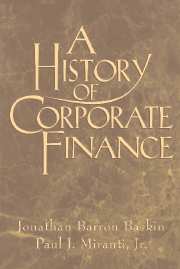Book contents
- Frontmatter
- Contents
- Preface
- Introduction: History and the Modern Theory of Finance
- Part I The Preindustrial World
- Part II The Rise of Modern Industry
- Part III The Transition to the Contemporary Era
- 6 The Financing of Center Firms, 1940–1973
- 7 Conglomerates and Leveraged-Buyout Partnerships
- Epilogue
- APPENDIX A Finance and Informational Asymmetries in the Ancient World
- APPENDIX B International Patterns of Corporate Governance
- Index
7 - Conglomerates and Leveraged-Buyout Partnerships
Published online by Cambridge University Press: 22 March 2010
- Frontmatter
- Contents
- Preface
- Introduction: History and the Modern Theory of Finance
- Part I The Preindustrial World
- Part II The Rise of Modern Industry
- Part III The Transition to the Contemporary Era
- 6 The Financing of Center Firms, 1940–1973
- 7 Conglomerates and Leveraged-Buyout Partnerships
- Epilogue
- APPENDIX A Finance and Informational Asymmetries in the Ancient World
- APPENDIX B International Patterns of Corporate Governance
- Index
Summary
Introduction
During the latter half of the twentieth century, two new types of business organization emerged for attracting investment capital: the conglomerate and the leveraged-buyout (LBO) partnership. Unlike center firms, these enterprises sought efficiency in financial innovation rather than in managerial or in technological innovation. And while both conglomerates and LBOs shared broadly similar objectives, the circumstances and rationales that supported their formation differed sharply.
As to conglomerates, their promotion during the 1960s and 1970s was initially predicated on the assumption that economic synergism could be achieved by applying modern management techniques to the combining of heterogeneous businesses. Although the diversification drives of conglomerates seemed superficially similar to the creation of center firms, the theoretical underpinnings lending support to these activities were not comparable to those that explain the policies of center firms and thus require a different understanding of the financial system.
Conglomerate acquisition was more sensitive to portfolio theory than to more effective coordination and control of complementary businesses. Nor did conglomerates usually penetrate industries in which operating economies of scale and scope could be realized. In fact, there was little evidence that conglomerate growth resulted from superior management. Instead, the growing size of these companies made possible the achievement of economies in financial transacting. In addition, their success in the financial markets stemmed from ma nipulating the looseness both in financial accounting standards relating to the measurement of consolidated net income and in tax rules relating to the allocation of unapplied credits and loss items.
- Type
- Chapter
- Information
- A History of Corporate Finance , pp. 258 - 302Publisher: Cambridge University PressPrint publication year: 1997
- 2
- Cited by



